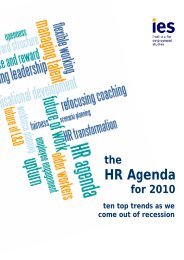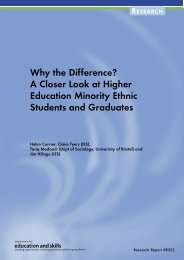Post-16 Transitions: a Longitudinal Study of Young People with ...
Post-16 Transitions: a Longitudinal Study of Young People with ...
Post-16 Transitions: a Longitudinal Study of Young People with ...
You also want an ePaper? Increase the reach of your titles
YUMPU automatically turns print PDFs into web optimized ePapers that Google loves.
10.2 Preparing for transition<br />
Generally the survey found that most young people <strong>with</strong> SEN had<br />
gained some sort <strong>of</strong> qualification from school, most were in<br />
education or employment, and most enjoyed active and busy<br />
social lives. However, this apparently positive general picture<br />
masks some key differences: in the types and levels <strong>of</strong><br />
qualifications gained, the courses being followed and the place <strong>of</strong><br />
study, and the quality or level <strong>of</strong> jobs being undertaken. On closer<br />
inspection, it is clear that some ‘groups’ <strong>of</strong> young people have a<br />
very different transition experience and fare better or worse<br />
depending on some key personal characteristics, such as the<br />
severity <strong>of</strong> need, the type <strong>of</strong> school attended, and/or the type <strong>of</strong><br />
special educational need. In many ways, a significant number <strong>of</strong><br />
young people in this study could be deemed to have deferred<br />
their post-<strong>16</strong> transition: they remain in their pre-<strong>16</strong> environment<br />
and are unlikely to make any significant moves for two to three<br />
years.<br />
The study has examined the influence that various supportive<br />
structures have had (or seem to have had) on these differential<br />
transitions and outcomes to date. In particular, it has looked at the<br />
impact <strong>of</strong> statutory transition planning on young people’s<br />
progress, and has explored the role <strong>of</strong> other formal structures and<br />
bodies, such as the Careers Service or Connexions, on the<br />
transition process generally. It has also looked at the role <strong>of</strong><br />
parents and carers in the transition process, and their views on it.<br />
The rest <strong>of</strong> this concluding chapter examines the evidence to<br />
ascertain:<br />
• the preparedness <strong>of</strong> young people <strong>with</strong> SEN to make their<br />
post-<strong>16</strong> transitions; and<br />
• the extent to which the transitions that young people <strong>with</strong><br />
SEN have made can be deemed to have been successful.<br />
10.2.1 Transition planning<br />
Transition planning forms a key element <strong>of</strong> government policy for<br />
young people <strong>with</strong> special educational needs. However, less than<br />
half <strong>of</strong> all the young people taking part in the Wave 2 survey<br />
could recall having any formal transition planning meeting to<br />
assist them to move on from compulsory schooling. In particular,<br />
just under two-thirds <strong>of</strong> young people <strong>with</strong> statements <strong>of</strong> SEN<br />
could recall attending a transition planning meeting prior to Year<br />
11 although all would have had a statutory right to formal<br />
assistance <strong>of</strong> this sort. This finding may be a problem <strong>of</strong> recall<br />
(approximately one-fifth <strong>of</strong> all young people surveyed could not<br />
remember if they had attended a planning meeting), but may also<br />
indicate that this sort <strong>of</strong> planning does not always happen as<br />
routinely as policy suggests it should.<br />
138<br />
<strong>Post</strong>-<strong>16</strong> <strong>Transitions</strong> <strong>of</strong> <strong>Young</strong> <strong>People</strong> <strong>with</strong> SEN: Wave 2

















